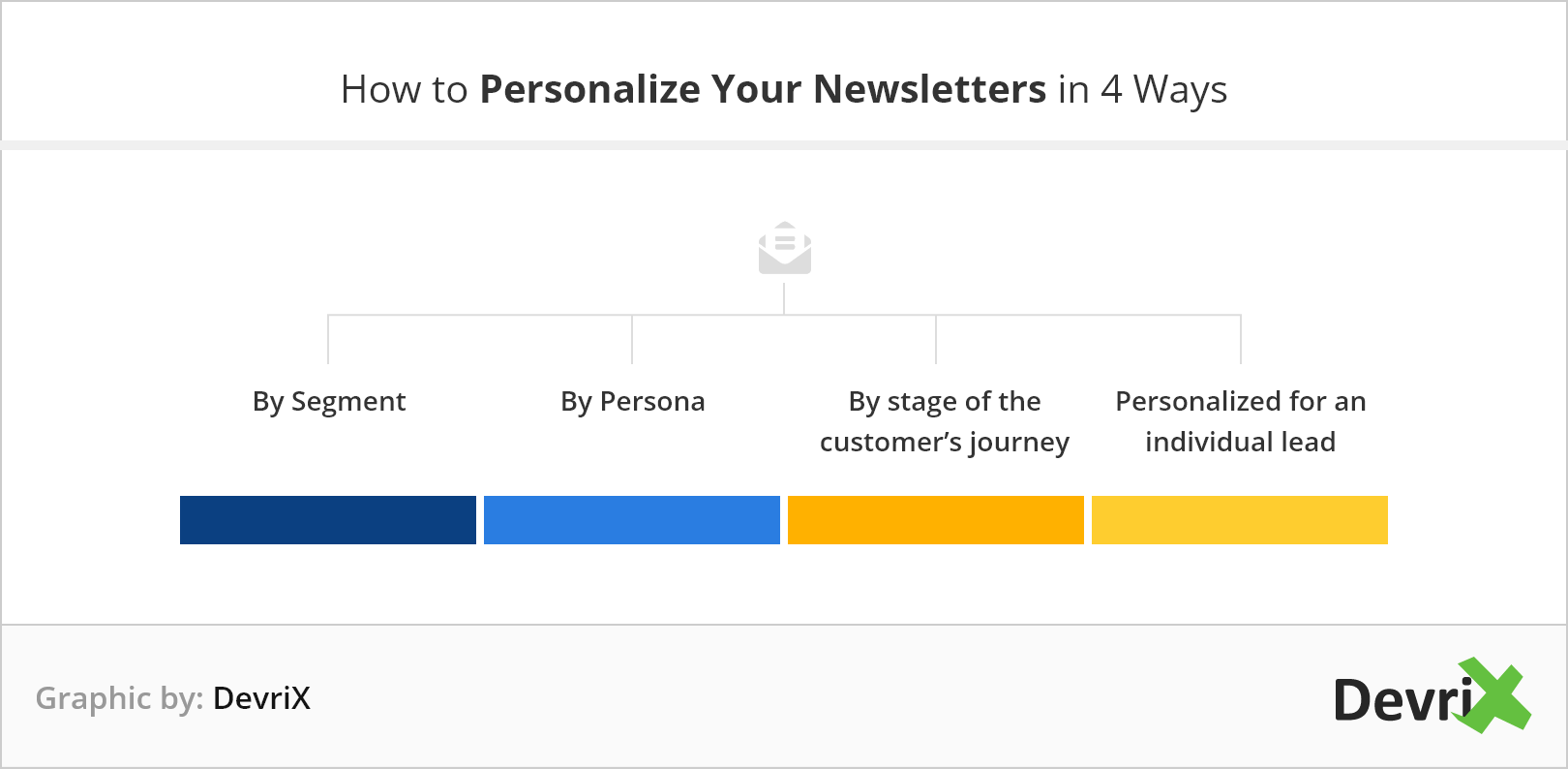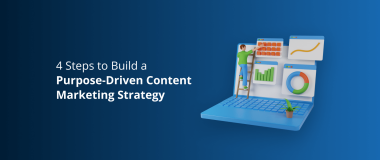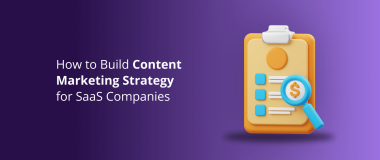As we all know content is one of the best ways to attract your customers. No matter if we are speaking about B2B or B2C. In the business-to-business (B2B) context, a content marketing strategy is important to build trust and a relationship with your B2B audience. According to research,
47% of B2B buyers consumed 3-5 pieces of content from a company before engaging with one of their sales representatives.
This is why an effective B2B content marketing strategy is necessary for your business.
In our first article, we listed six ways on how to strengthen your B2B content strategy focusing on storytelling, webinars, podcasts, video, infographics, interactive content.
In this article, we’ll continue sharing tips in order to improve your content marketing strategy and create a better relationship with your B2B audience delivering content that educates.
The graphic above of the recent research by the Content Marketing Institute shows the top three types of content B2B marketers use are:
- Social media content
- Blog posts or short article
- Email newsletters
In this article, we will be focusing on the three of them as well as adding a few more tips to help you with your content marketing strategy for your B2B clients.
1. You Are Not Forgetting to Use Social Media Channels, Right?
You can’t skip social media channels. It’s where everyone is – end-users and brands. This is a place where you can show your human side and interact with your audience. You can create posts stimulating comments or shares.
There is no magic formula, the best thing you can do is to experiment with the content you deliver to your target audience and find out what works best for you.
The data presented by Backlinko shows the following statistics:
- Facebook is the top social media platform for both B2B and B2C, while LinkedIn is the second most important platform for B2B.
- 91% of executives name LinkedIn as the top choice for content that is professionally relevant.
As seen above, Facebook and LinkedIn dominate as social media channels where you can connect better with your audience hold conversations, discussions or interactions.
Also LinkedIn, Facebook and Instagram have good targeting tools, so you can invest in paid ads. This way you can distribute your content and you can be sure it reaches the right target audience.
Many businesses make a huge mistake in neglecting their social media channels. Learn from their mistakes.
2. Does Your Business Blog Work for You?
Although it may sound obvious that you need to have a good business blog, it’s still worth mentioning. According to the statistics above blog posts or short articles are the second type of B2B content that marketers use.
Blogging is one of the easiest ways to educate your audience. If you are not able to produce fresh content constantly, you can update your old ones by adding new statistics, studies or information.
In fact, according to the statistics above, it’s not always necessary to write long articles. The data says that short blog posts or articles work great. Sometimes a short blog post, but one that is useful, can perform better and bring more traffic to your website than a 2000 word article.
For instance this article – “Get ready for WordCamp Sofia 2019!” it’s not a long one, but it drives notable traffic to our blog, because it contains useful information for our target audience about the WordCamp Sofia.
This means you can consider shorter articles about events happening around you that may be interesting for your audience.
To make sure you are following the blogging trends check out this article where you can learn about 8 Practical Blogging Trends for 2020.
3. Do You Send Out Personalized Newsletters? If Not You Should
Newsletters were the third most used type of content that marketers prefer.
According to a study done by Content Marketing Institute, 79% of B2B marketers report email as being the most successful channel to distribute content. That means that if you want to spread your content to B2B audience, email is also a great tool.
In order to strengthen your content strategy, you need to think about personalizing your content.
No one wants to receive the same newsletter as many other people. People want to feel unique and special. The same applies to B2B companies.
Business customers often want info on their return on investment (ROI) and how to grow their business. You can use this data as topic ideas or details which you might include in your newsletters.

If you didn’t have an actual strategy on how to personalize your newsletter, now is the time to think about one. There are a few ways you can personalize your emails:
- By Segment – personalized by industry vertical or segment criteria
- By Persona – personalized for specific buyer types
- By stage of the customer’s journey
- Personalized for an individual lead
Consider what’s most suitable for your business and your clients. If you don’t have the relevant data, you can experiment. Research the above ideas and find out which are the most convenient ones for you and your business.
If you want to increase your B2B sales with email marketing check out this great tutorial.
4. Do You Provoke Your Audience’s Interest With Special Offers?
When speaking about newsletters, why don’t you try adding special offers or promotions to your target audience?
People love to feel special and taken care of. If you also try sending them special offers, discounts or giveaways, you will stimulate your B2B audience’s interest. Imagine if you run a company and you receive an email with a useful article and tips that you can apply. And now imagine if there is a special free trial just for you. Sounds interesting, doesn’t it?
When you offer special discounts or free trials don’t forget to communicate clearly the timeframe in which the promotion is active and don’t forget the call to action button.
5. Do You Create Content That Will Educate Your Audience?

For the B2B audience, useful and educational content is more than important because this will help you build trust. There are different formats you can use to educate your customers such as whitepapers, e-books.
The main advantage of these formats is that they all are downloadable. This means you can ask for an email address and also for additional information – like the size of the company, where it is located, etc. to develop a data basis you can use later to send out newsletters or special promotions. Also, the additional details will help you to learn more about the company which can come in handy when crafting your personalized newsletters.
If you are worried that asking additional questions will somehow have a negative effect, research shows that 80% of users would provide their emails for a whitepaper or an e-book.
Let’s have a look at the most common types of content that educate your customers:
Whitepapers
Whitepapers are professional reports presenting specific problems and their solutions. Usually, they are in PDF format and customers will need to provide their emails so they can download them from their inbox.
A few important tips you need to follow when preparing your whitepaper:
- Present your data with charts, illustrations or any other visual means.
- Usually, whitepapers are quite long and according to Hubspot, they should be at least six pages.
- The style should be professional in terms of writing, wording, and design.
E-books
Similar to whitepapers, e-books are great ways to educate your customers. The difference in comparison with the white papers is that e-books are informal style and engaging. Usually, they contain links you can follow to other resources, videos or other interactive content.
You have more freedom and can be more creative with your topics, the design and content.
6. Do You Brag About Your Successful Projects with Case Studies?
Case studies are a classical example of content marketing which can help prove you are an expert who can solve problems in a creative way. According to statistics published by Hubspot case studies help convert and accelerate the most leads.
Speaking in the B2B context a case study can do wonders for you. Having case studies on your website will help build trust in your future customers. The idea of the case study is to show a problem, then your creative approach and the solution.
You can choose among different formats – they can be a video or written as a blog post. Check out this example written by DevriX.
If you need a detailed guide on how to make valuable B2B case studies check this tutorial on how to write B2B case studies: a practical guide.
Wrap Up
This was the second article on how to strengthen your B2B content marketing strategy. In this blog post, we have focussed on personalization and tips on how you can educate your customers.
According to the data for this year, the top three types of content that marketers focus on are social media content, business blog posts, and newsletters. We have listed other ideas you can try like providing special offers or creating whitepapers and e-books. Case studies are always a good way to show that you have designed great solutions for your clients.
Don’t waste time, choose the most relevant ideas for your business and your audience and try them out.



![6 Ways to Strengthen Your B2B Content Marketing Strategy [Part 1]](https://devrix.com/wp-content/uploads/2019/12/6-Ways-to-Strengthen-Your-B2B-Content-Marketing-Strategy-Part-1@2x-380x160.png)


